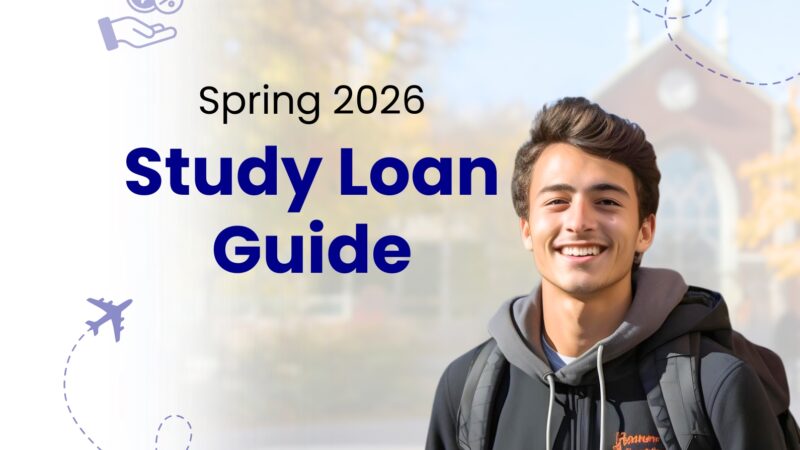
ROI-Based University Selection: Why Rankings Alone Don’t Matter Anymore
In this article
- University rankings are helpful—but they’re not the full picture.
- Why ROI Now Matters More Than Ever for International Students?
- Why Rankings Mislead International Students?
- What a High-ROI University Looks Like?
- Best Country for Masters for Indian Students (In ROI Terms)
- How to Calculate Your Own ROI?
- Conclusion: Choose Value. Not Just Rank.
- Frequently Asked Questions
Planning to study a masters abroad in 2026? If you’re scanning through global university rankings to make your decision, stop right there.
University rankings are helpful—but they’re not the full picture.
What truly matters today is ROI (Return on Investment). How much you spend versus how much you earn post-graduation. Especially if you’re taking an education loan or self-funding to study masters abroad, the cost-to-career ratio can define your future financial freedom.
So let’s cut through the shiny logos and high QS rankings. In today’s post-COVID, inflation-sensitive, visa-conscious world, ranking alone doesn’t guarantee success. Here’s what you really need to look at.
Why ROI Now Matters More Than Ever for International Students?
University education—especially international master’s programs—is expensive. The tuition fees, living expenses, and loan interests can easily reach ₹40–80 lakhs for a two-year course.
The traditional approach:
“Pick a top 100 university. Surely that’s a good bet.”
But in reality:
- A top-ranked university in a low-demand job location could lead to long job hunts.
- A mid-tier university with a strong local job market could land you a job in 60 days.
- Some expensive schools offer little to no scholarships, while others cover 50%+ of your tuition.
Today, value matters more than the brand. And that’s where ROI-based selection wins.
Why Rankings Mislead International Students?
When planning to study in the United States or any major destination, rankings may seem like a simple way to compare universities. But here’s the catch:
- They focus on research output — which doesn’t matter unless you’re pursuing a PhD.
- They rarely reflect employability — especially for international students.
- They often ignore cost of living, scholarships, and career services.
Thus MIT or Stanford may be first on the list, but a small university with programs in demand, assistantship openings and near employment areas may be a better (ROI) choice.
What a High-ROI University Looks Like?
Here’s what to prioritize instead of just rank:
1. Affordability
- Scholarships, assistantships, tuition waivers.
- On-campus job availability
- Cities with low cost of living (e.g., Austin, Eindhoven, Waterloo).
2. Employment Outcomes
- The rate of job placement of international graduates of university.
- In big firms with alumni network.
- Success of Optional Practical Training (OPT) or Post-Study Work Visa.
3. Industry-Aligned Programs
- Courses in emerging fields: data science, AI, renewable energy
- Internship tie-ups with companies
- Capstone or co-op programs embedded in the degree
4. Geographical Advantage
- Near tech hubs or financial centers
- Regions with high H-1B or visa sponsorship rates
- Job-friendliness toward Indian graduates
Best Country for Masters for Indian Students (In ROI Terms)
While the USA is still the best country for master’s for Indian students, it’s no longer the only logical ROI option.
Here’s a quick breakdown:
- USA: High salaries, high tuition. Choose only if you get funding or post-study job assurance.
- Canada: Lower tuition, strong PR pathway, good work-study balance.
- Germany: Low to no tuition fees, strong STEM programs, but language can be a barrier.
- Ireland: One-year programs, tech jobs, easy visa, slightly expensive living.
- Australia: Two-year stay-back, scholarships, growing tech hiring.
There is an advantage and a disadvantage in every country. However, the best bet for Indian students in 2026 is to consider a country-university pair with high ROI, not just prestige.
How to Calculate Your Own ROI?
Here’s a simple formula:
ROI Payback Time = Total Cost ÷ Expected Annual Salary
The shorter the payback time, the higher the ROI.
A high-ranked school with a five-year payback is worse than a mid-ranked one with a two-year payback, financially speaking.
Also consider:
- Loan EMIs
- Living expenses in that country
- Currency strength & taxation on international income
Final Checklist for ROI-Based Selection
Before you say yes to that admit offer, ask yourself:
- What’s the total cost (including hidden fees)?
- How many grads from my course get jobs in 3–6 months?
- What is the average post-grad salary?
- Is the course aligned with hiring trends?
- How long will I take to repay the investment?
This approach takes a bit more work than trusting rankings. But it gives you a realistic, sustainable education plan.
Conclusion: Choose Value. Not Just Rank.
In 2026, don’t just chase a name. Chase return, relevance, and real outcomes. Choose a university where your investment pays you back—not just one that looks good on paper.

Frequently Asked Questions
Is it better to pick a top-ranked university or one with higher ROI?
ROI must be a priority in case of self-investing or borrowing. A university of slightly lesser rank, one with good employment placement, and a relatively affordable price can be a less costly long-term decision.
Which countries offer the best ROI for Indian students?
Germany, Canada, and Ireland are currently leading for ROI. The USA offers high-paying jobs but comes with higher upfront costs. Germany is especially strong for STEM fields.
What’s the average ROI for studying in the United States?
For top 50 US universities, the average payback time is 4–5 years. However, many state universities offer faster ROI (2–3 years) with in-state tuition, scholarships, or assistantships.
Can a university’s job placement rate be trusted?
Partially. Always look at outcomes for international students, not the general pool. Alumni reviews, LinkedIn searches, and employer tie-ups give better insight than marketing stats.
What role does location play in ROI?
Huge role. Universities near tech, finance, or manufacturing hubs tend to have better placement opportunities. Cities like Boston, Toronto, Munich, and Dublin boost job visibility.
Book A Free Counseling
Related Blogs
Want to connect with
Our Experts?
We provide keep one to one counselling to
Study Abroad Aspirants









